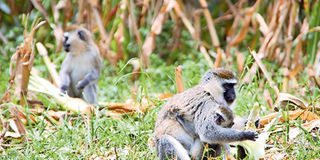Agronomist's notebook: Tricks to keep wild animals out of the farm

Monkeys in a maize farm. The primates are irritated by the smell of fish and if the farmer places dead fish in places where the monkeys are most likely to pass and touch them, they would keep off the farm. Once it touches a smelly fish, a monkey will rub its hands against stones to get rid of the smell, in the process wounding itself. FILE PHOTO | NMG
What you need to know:
- Most farmers use rudimentary methods like erecting scarecrows on the farm or hunting the animals to keep them at bay.
- Placing of hose pipes and water-pistols at various intervals on the farm also aid in scaring them away. However, this is workable in areas where there is plenty of water.
- Fencing the shamba with nets is normally the best way to protect crops against monkeys but it is expensive.
- Making raised and narrow beds on the farm can also be used to curb invasions of squirrels since the animals avoid areas where predators can easily spot them.
One of the major challenges farmers living near forests or game parks face is the invasion of farms by wild animals.
The animals cause huge losses to farmers not only by destroying crops or attacking livestock, they make them incur unnecessary costs arising from erection of fences or employing people to chase them away.
Monkeys, birds, elephants, squirrels, hippos, moles, porcupines and buffaloes are some of the wild animals that attack farms.
Most farmers use rudimentary methods like erecting scarecrows on the farm or hunting the animals to keep them at bay.
However, there are several simple practices farmers can use effectively.
In the case of monkeys, scattering toy snakes of different colours on the farm will scare away the primates away.
But when using this method, farmers have to keep changing the location of the toy snakes to stop the monkeys from thinking the reptiles are static.
Placing of hose pipes and water-pistols at various intervals on the farm also aid in scaring them away. However, this is workable in areas where there is plenty of water.
Also, monkeys are irritated by the smell of fish. If the farmer places dead fish in places where the monkeys are most likely to pass and touch them, the invaders would keep off the farm.
Once it touches a smelly fish, a monkey will rub its hands against stones to get rid of the smell, in the process wounding itself.
Fencing the shamba with nets is normally the best way to protect crops against monkeys but it is expensive.
A long-term measure to curb a rise in monkey population is putting oral contraceptives in fruits and offering them.
Porcupines and squirrels also destroy field crops. Adding sawdust as a mulch helps hinder their navigation on the farm, making them less frequent visitors.
KEEPING BEES ON THE FARM
Spraying the field crops with pepper-based chemicals also makes the rodents unable to feed on the crops. Other methods that can be used include fencing the farm with a wire mesh or use of poison-baits, which, however, is not eco-friendly.
Making raised and narrow beds on the farm can also be used to curb invasions of squirrels since the animals avoid areas where predators can easily spot them.
On the other hand, moles attack tuber and fodder crops such as napier grass. Castor weed produces a good oil to repel the rodents.
When the castor seeds are harvested, crushed and mixed with soil, they produce an unpleasant smell that moles don’t like.
Rodenticides can also be used to control squirrels, porcupines, and moles.
However, this method is not recommended since it can cause long residue effect in the soil and air. Use of homemade traps to control the pest also works well.
For elephants, dog barks or bees may be enough to scare them away from your bananas. Therefore, keeping bees on the edges of the farm helps.
Farms near water bodies face hippopotamus attacks during the night. Hippos are controlled by making terraces around the farm. A terrace of about 2m depth and 1.5m in width works well.
Bird infestation is worse in areas where rice and millet are grown. The use of scarecrows, covering corn ears with paper bags, use of nets, hawk decoy, bird diverters, bird busters, and flash tapes are among the best ways to control their attacks.
Lastly, while electric fences keep most of the predators away, the method is quite expensive. Farmers are also advised to plant crops that are less attacked by target animals.





